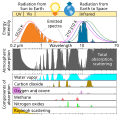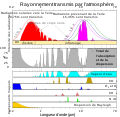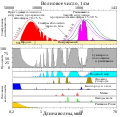Αρχείο:Atmospheric Transmission.svg

Το μέγεθος αυτής της PNG προεπισκόπησης αυτού του SVG το αρχείο: 614 × 600 εικονοστοιχεία. Άλλες αναλύσεις: 246 × 240 εικονοστοιχεία | 491 × 480 εικονοστοιχεία | 786 × 768 εικονοστοιχεία | 1.048 × 1.024 εικονοστοιχεία | 2.096 × 2.048 εικονοστοιχεία | 741 × 724 εικονοστοιχεία.
Εικόνα σε υψηλότερη ανάλυση (Αρχείο SVG, ονομαστικό μέγεθος 741 × 724 εικονοστοιχεία, μέγεθος αρχείου: 321 KB)
Ιστορικό αρχείου
Κλικάρετε σε μια ημερομηνία/ώρα για να δείτε το αρχείο όπως εμφανιζόταν εκείνη τη στιγμή.
| Ώρα/Ημερομ. | Μικρογραφία | Διαστάσεις | Χρήστης | Σχόλια | |
|---|---|---|---|---|---|
| τελευταία | 16:19, 18 Απριλίου 2023 |  | 741 × 724 (321 KB) | Efbrazil | Adding white background color so renders correctly on smartphone |
| 20:29, 7 Αυγούστου 2022 |  | 741 × 724 (321 KB) | Efbrazil | color bug fix | |
| 20:00, 7 Αυγούστου 2022 |  | 741 × 724 (321 KB) | Efbrazil | Fixed translations as best as possible using text editor for new layout | |
| 19:34, 7 Αυγούστου 2022 |  | 741 × 724 (320 KB) | Efbrazil | Fixing text alignment | |
| 19:26, 7 Αυγούστου 2022 |  | 741 × 724 (320 KB) | Efbrazil | Graphical improvements as per discussion page | |
| 17:59, 17 Φεβρουαρίου 2022 |  | 741 × 724 (208 KB) | Pierre cb | File uploaded using svgtranslate tool (https://svgtranslate.toolforge.org/). Added translation for fr. | |
| 22:10, 18 Μαρτίου 2021 |  | 741 × 724 (180 KB) | Cepheiden | german labels adjusted | |
| 22:09, 18 Μαρτίου 2021 |  | 741 × 724 (180 KB) | Cepheiden | correction of labels | |
| 22:06, 18 Μαρτίου 2021 |  | 741 × 724 (180 KB) | Cepheiden | File uploaded using svgtranslate tool (https://svgtranslate.toolforge.org/). Added translation for de. | |
| 21:52, 18 Μαρτίου 2021 |  | 741 × 724 (154 KB) | Cepheiden | =={{int:filedesc}}== {{Information |description= {{en|1=This figure shows the absorption bands in the Earth's atmosphere (middle panel) and the effect that this has on both solar radiation and upgoing thermal radiation (top panel). Individual absorption spectrum for major greenhouse gases plus Rayleigh scattering are shown in the lower panel.}} |date=2021-03-18 |source=This figure was prepared by Robert A. Rohde for the Global Warming Art project. |author=[[User:Д.Ил... |
Συνδέσεις αρχείου
Τα παρακάτω λήμματα συνδέουν σε αυτό το αρχείο:
Καθολική χρήση αρχείου
Τα ακόλουθα άλλα wiki χρησιμοποιούν αυτό το αρχείο:
- Χρήση σε ar.wikipedia.org
- Χρήση σε de.wikipedia.org
- Χρήση σε en.wikipedia.org
- Χρήση σε fr.wikipedia.org
- Χρήση σε gl.wikipedia.org
- Χρήση σε ha.wikipedia.org
- Χρήση σε ig.wikipedia.org
- Χρήση σε pt.wikipedia.org
- Χρήση σε simple.wikipedia.org
- Χρήση σε zh.wikipedia.org










